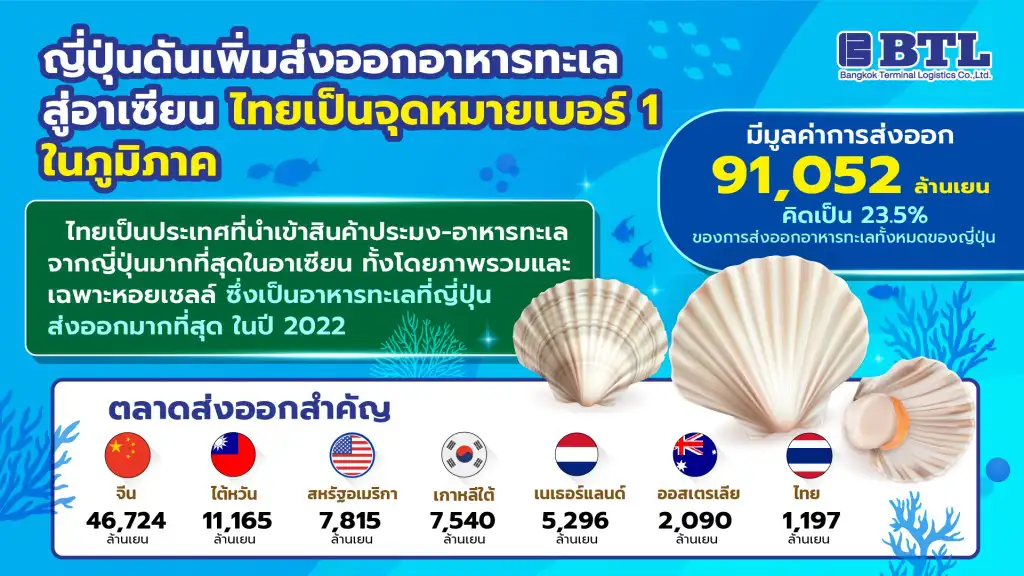



Japan loses its most important seafood export market as China and Hong Kong ban imports of fresh and processed Japanese seafood.
As China and Hong Kong ban the import of fresh and processed Japanese seafood, Japan is trying to accelerate its seafood exports to the ASEAN region, by promoting and marketing it in various ways.
In late October 2023, the Japan External Trade Organization (JETRO Bangkok) launched the “HOTATE Festival” campaign, a hotate scallop festival directly from Japan, to promote and encourage Thai consumers to become more familiar with and consume premium hotate scallops from Japan.
Aiming to promote consumption-stimulating activities in collaboration with importers, restaurant operators and retailers to expand distribution channels in new market segments in Thailand.
Followed by the “ASEAN Media Event” activity where the “Ministry of Agriculture, Forestry and Fisheries” of Japan invited media, bloggers, and influencers from 4 ASEAN countries: Thailand, Singapore, Malaysia, and the Philippines.
Experience tasting fresh scallops and sea cucumbers and visit the production process, from cultivation to processing, in Aomori City and Hokkaido. Prachachat Business is one of two Thai media and bloggers who were invited to join this event last December.
Japan’s agriculture ministry is straightforward, saying the event aims to promote the appeal of Japanese scallops, sea cucumbers and other Japanese fishery products to consumers in ASEAN countries.
The aim is to expand exports, both by adding new export destinations and increasing export volumes to existing destinations where they are already performing well.
Although the event focuses on promoting scallops and sea cucumbers, the Japanese Ministry of Agriculture says Japan wants to promote fishery and seafood exports overall.
In 2022, Japan’s total export value of fishery products was 387.3 billion yen (approximately 93.967 billion baht). The top export destinations were China (87.1 billion yen), Hong Kong (75.5 billion yen), the United States (53.9 billion yen), Taiwan (34.6 billion yen), South Korea (24.4 billion yen), Thailand (23.5 billion yen), Vietnam (21.6 billion yen), and Singapore (9.6 billion yen).
For scallops, which are Japan’s largest seafood export, in 2022, the export value was 91.052 billion yen, accounting for 23.5% of Japan’s total seafood exports.
The main export markets are China (46,724 million yen), Taiwan (11,165 million yen), the United States (7,815 million yen), South Korea (7,540 million yen), the Netherlands (5,296 million yen), Australia (2,090 million yen), and Thailand (1,197 million yen).
From this information, it can be seen that Thailand is the country that imports the most fishery and seafood products from Japan in ASEAN.
Both in general and specifically scallops
In the big picture, Japan’s exports of agricultural, forestry, fisheries and food products were estimated to be 1.4 trillion yen in 2023, and Japan aims to increase exports to 2 trillion yen by 2025 and 5 trillion yen by 2023, with fisheries products as one of its major exports.
“With these activities, Japan aims to increase the value of global exports of agricultural, forestry and fisheries products and food to 2 trillion yen by 2025 and 5 trillion yen by 2030.
and hope to export to ASEAN countries at a growth rate close to or higher than the global export growth rate,” said the Deputy Director of the Export Policy Planning Division, Export and Foreign Affairs Bureau, Ministry of Agriculture, Forestry and Fisheries of Japan, explaining the goal.
Source of information: Prachachat Business
————————–
Contact us for BTL service inquiries
02-681-2005 to 9